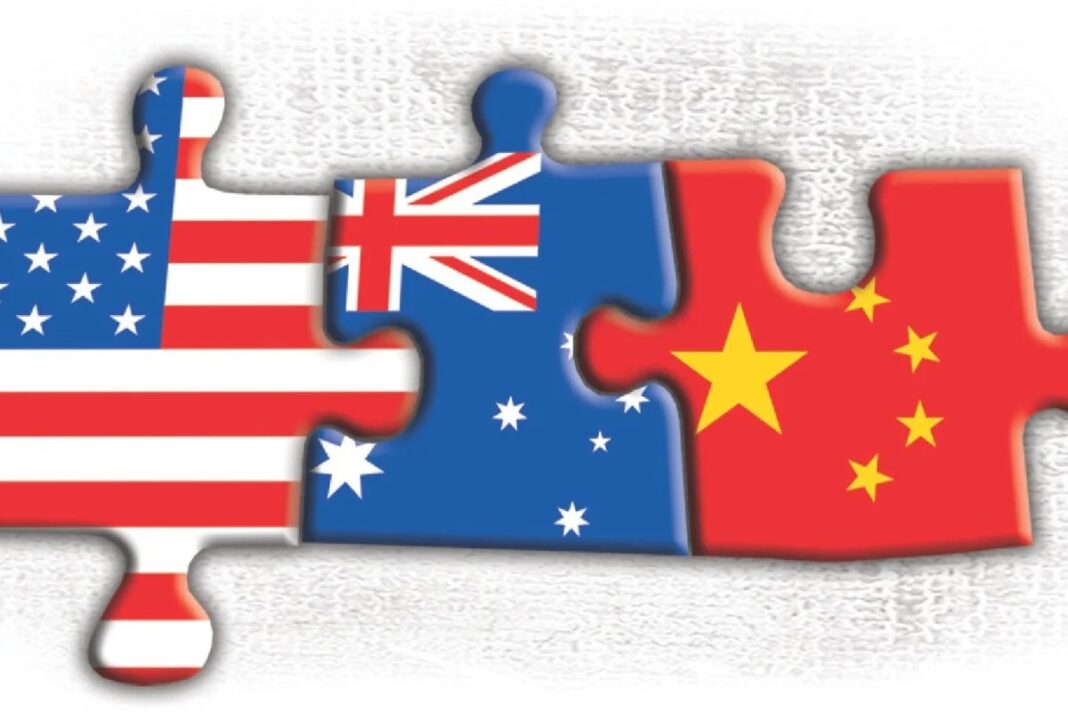By Dr Majid Khan
Melbourne(London Post) – Australia’s trade relationships with the United States (US) and China are central to its economic prosperity. As two of Australia’s largest trading partners, the US and China play a significant role in shaping the nation’s export and import dynamics.
Australia’s economy is heavily reliant on international trade, with the US and China accounting for a substantial share of its trade volume. China remains Australia’s largest trading partner, while the US is a critical ally and a major source of investment and technology. The financial year 2024-2025 has seen significant shifts in global trade dynamics, influenced by geopolitical tensions, economic recovery post-pandemic, and the legacy of Trump’s protectionist policies.
Australia-China Trade
China continues to dominate Australia’s trade landscape, accounting for approximately 28% of Australia’s total trade in goods and services in the financial year 2024-2025. The total trade volume between Australia and China reached AUD 285 billion, with exports to China valued at AUD 195 billion and imports at AUD 90 billion. Australia’s exports to China remain heavily reliant on natural resources, with iron ore, coal, and natural gas constituting over 75% of total exports. Iron ore alone contributed AUD 120 billion, underscoring its critical role in the bilateral trade relationship.
Despite ongoing geopolitical tensions, the trade volume has remained robust, driven by China’s demand for Australia’s natural resources. However, the diversification of Australia’s export markets has gained momentum, with increased focus on Southeast Asia and India. The financial year 2024-2025 also saw a partial recovery in Australian agricultural exports to China, particularly barley and wine, following the easing of some trade restrictions.
Australia-US Trade
The United States remains Australia’s second-largest trading partner and a key source of foreign direct investment (FDI). In the financial year 2024-2025, the total trade volume between Australia and the US stood at approximately AUD 85 billion, with exports to the US valued at AUD 27 billion and imports at AUD 58 billion. Major Australian exports to the US include beef, alcoholic beverages, and machinery, while imports from the US are dominated by aircraft, medical equipment, and pharmaceuticals.
The US continues to be Australia’s largest source of FDI, with investments totaling over AUD 1.2 trillion in sectors such as mining, technology, and finance. The Australia-United States Free Trade Agreement (AUSFTA) remains a cornerstone of the bilateral trade relationship, facilitating seamless trade and investment flows.
Read More:https://londonpost.news/australias-student-visa-policy-and-its-impact/
Impact of Trump’s Protective Trade Policies
The Trump administration’s “America First” policy, characterized by increased tariffs, trade barriers, and a focus on reducing trade deficits, continues to influence global trade dynamics. Key measures included the imposition of tariffs on Chinese goods, renegotiation of trade agreements, and withdrawal from the Trans-Pacific Partnership (TPP). These policies had ripple effects on Australia’s trade relationships.
- Impact on Australia-China Trade: Trump’s trade war with China created both challenges and opportunities for Australia. While China’s retaliatory tariffs on US goods initially led to increased demand for Australian agricultural products, the subsequent geopolitical tensions resulted in trade restrictions on Australian exports. However, the financial year 2024-2025 has seen a partial normalization of trade relations, with some restrictions being eased.
- Impact on Australia-US Trade: Trump’s protectionist policies had a mixed impact on Australia-US trade. While the AUSFTA provided a stable framework for trade, the overall uncertainty in global trade dynamics under Trump’s administration led to cautious investment and trade behavior. The financial year 2024-2025 has seen a resurgence in trade and investment flows, driven by the Biden administration’s focus on rebuilding alliances and promoting free trade.
Future Prospects of Australia’s Trade with China and the US
The future of Australia’s trade with China and the US will be shaped by several factors, including geopolitical developments, economic policies, and global market trends.
- Australia-China Trade: Despite recent tensions, China’s demand for Australian resources is expected to remain strong, driven by its infrastructure development and industrial growth. However, Australia is likely to continue diversifying its export markets to reduce its dependence on China. The Regional Comprehensive Economic Partnership (RCEP), which includes China and Australia, could provide new opportunities for trade expansion. Additionally, Australia’s focus on renewable energy and critical minerals, such as lithium and rare earths, aligns with China’s green energy ambitions, offering potential for future collaboration.
- Australia-US Trade: The US remains a vital partner for Australia, particularly in the areas of technology, defense, and investment. The Biden administration’s focus on rebuilding alliances and promoting free trade is expected to strengthen bilateral ties. The US’s increasing emphasis on supply chain resilience and critical minerals presents opportunities for Australia, given its abundant reserves of these resources. Furthermore, the AUKUS partnership, which includes the US, UK, and Australia, underscores the strategic importance of the Australia-US relationship and could lead to enhanced economic cooperation.
- Geopolitical Considerations: The ongoing US-China rivalry will continue to influence Australia’s trade dynamics. Australia’s ability to maintain a balanced approach in its relationships with both nations will be crucial. While China remains an indispensable economic partner, Australia’s alignment with the US on strategic and security issues could lead to further diversification of trade and investment.
Australia’s trade relationships with the US and China are integral to its economic success. While China dominates Australia’s export market, particularly in natural resources, the US remains a critical partner in investment and technology.
Looking ahead, Australia’s ability to navigate the complexities of the US-China rivalry, diversify its trade portfolio, and capitalize on emerging opportunities will determine the future trajectory of its trade with these two economic powerhouses. As global trade dynamics continue to evolve, Australia must remain agile and proactive in strengthening its economic partnerships while safeguarding its national interests.
INPS Japan/London Post


